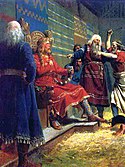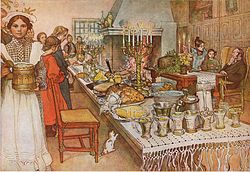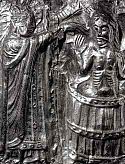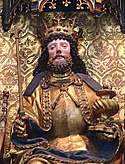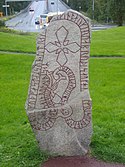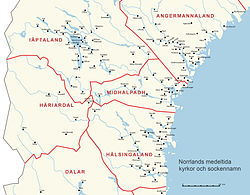Midvinterblot
When Carl Larsson had completed his painting showing Gustav Vasa's entry into Stockholm there was just one wall panel left empty at the museum. It is not surprising that Carl Larsson also wanted to fill it. And without the museum commissioning a painting or organizing a competition, Carl Larsson submitted a design of his own in 1911. As a contrast to midsummer which was portrayed in the Gustav Vasa panel he chose as his subject a Midwinter Sacrifice from Viking times. And as a complement to the royal triumph of Gustav Vasa he proposed a picture of a king being sacrificed for the good of his people.
The sketch gave rise to vociferous criticism when it was exhibited at the Nationalmuseum in 1911. Experts accused Carl Larsson of mixing together items from different periods of history. His vision was historically incorrect. Added to which, historical painting, such as the proposed Midwinter Sacrifice, had become less fashionable.
As opposition to his proposed painting grew, so did Carl Larsson's determination to carry out the project. As the most celebrated painter in Sweden he invested all his artistic prestige and he completed the vast painting at his own expense. The 80m2 canvas was temporarily hung in the museum in 1915. But after much debate all the way up to cabinet level, the painting was refused. It was taken down and, following the death of Carl Larsson in 1919, was shown at the Museum of Sketches in Lund for almost 40 years.
In 1983 the Midwinter Sacrifice was shown in Stockholm for the first time since 1915. It was borrowed for an exhibition on myths at the Museum of National Antiquities. Following this exhibition the painting was sold by the heirs of Carl Larsson to a Swedish art dealer. The Nationalmuseum refused an opportunity of buying the painting. The Museum of National Antiquities was interested in acquiring it but could not afford the price. A national collection to purchase the Midwinter Sacrifice was discussed but came to nothing. At the same time there was lively discussion in the press as to whether the painting ought to hang in the Nationalmuseum or not. Some people claimed that it did not have the artistic quality that one could demand of a work hung in the Nationalmuseum. Nor was the Old Norse subject matter relevant to the Nationalmuseum in that the historical collections had been removed in the 1930s to form the Museum of National Antiquities. In 1987 the Midwinter Sacrifice was sold at auction in London. It was acquired by a Japanese collector who greatly admired the painting. It was generally assumed that Sweden had now lost the painting.
But when the Nationalmuseum celebrated its bicentenary in 1992 with a major Carl Larsson exhibition, the Midwinter Sacrifice was borrowed from its Japanese owner. It was displayed in the entrance hall for the first time since 1915. Three-hundred thousand visitors saw the exhibition and a majority of them were positive towards the Midwinter Sacrifice. In 1997, after lengthy negotiations and thanks to generous financial help from private donors and foundations the Nationalmuseum was able to purchase Carl Larsson's Midwinter Sacrifice.Der Urheber dieses Werks ist 1919 gestorben; es ist daher gemeinfrei, weil seine urheberrechtliche Schutzfrist abgelaufen ist.
Dies gilt für das Herkunftsland des Werks und alle weiteren Staaten mit einer gesetzlichen Schutzfrist von 100 oder weniger Jahren nach dem Tod des Urhebers.
Relevante Bilder
Relevante Artikel
Christianisierung SkandinaviensDie Einführung des Christentums erst in Dänemark, dann in Skandinavien und schließlich in ganz Nordeuropa erfolgte im 10. bzw. 11. Jahrhundert und erreichte ihren Höhepunkt um das Jahr 1000. Sie war verbunden mit kriegerischen Auseinandersetzungen und wurde sowohl von der Wikingerzeit als auch von der dänischen, norwegischen und schwedischen Reichseinigung überlagert. Mit der Christianisierung der Wikinger wurden auch Dänen, Norweger und Schweden christianisiert und bildeten im 12. Jahrhundert schließlich eigene Nationalkirchen, die im 12. und 13. Jahrhundert ihrerseits dann Wenden, Finnen und Balten christianisierten. .. weiterlesen
Carl LarssonCarl Olof Larsson war ein schwedischer Künstler. .. weiterlesen




